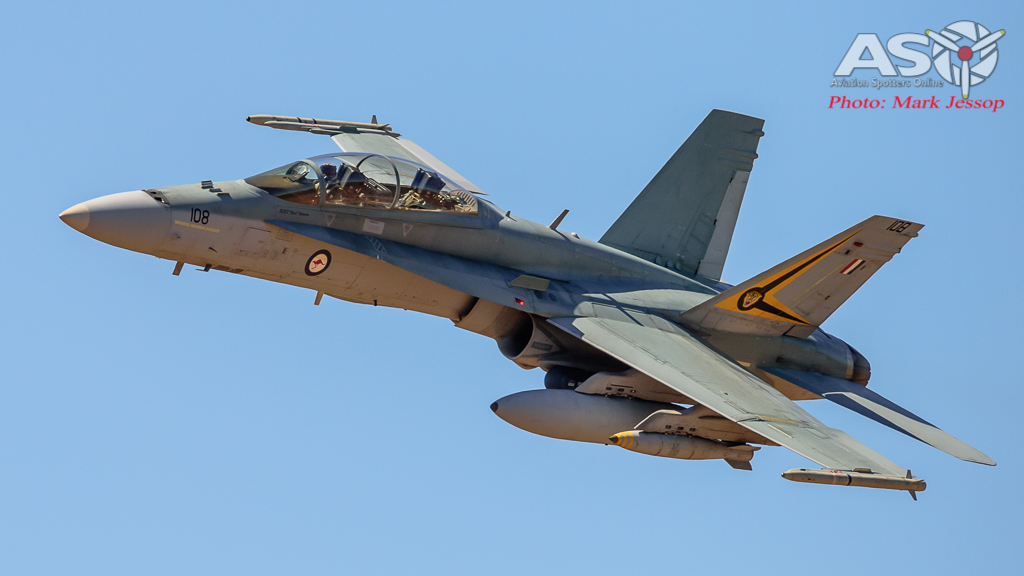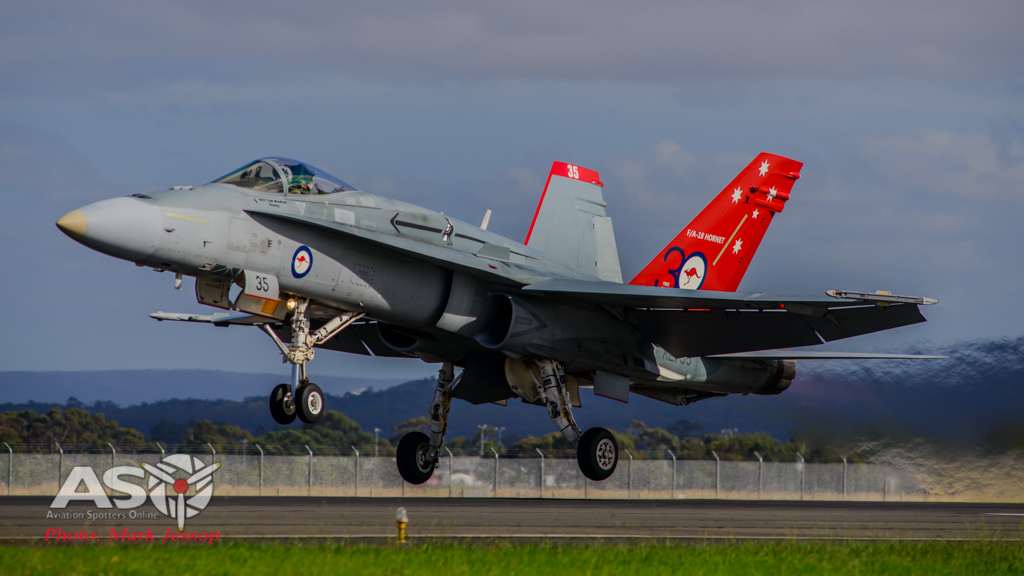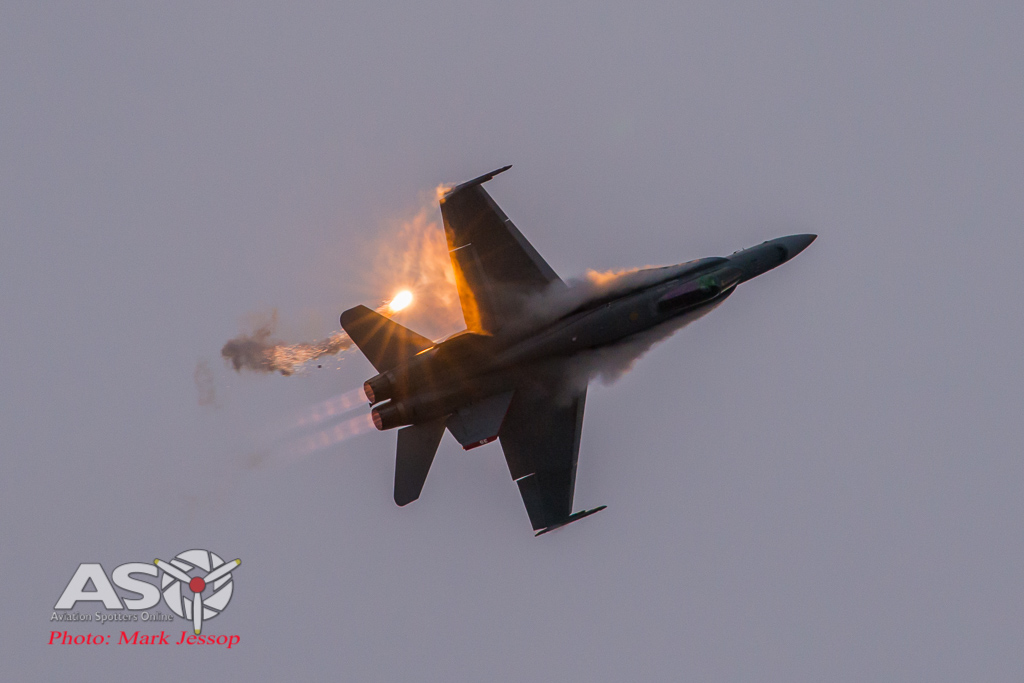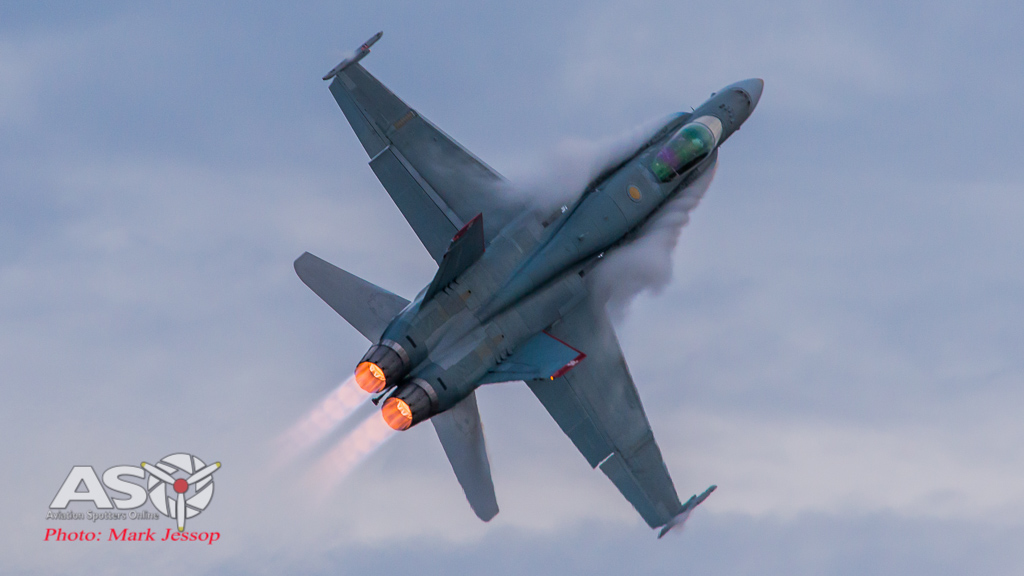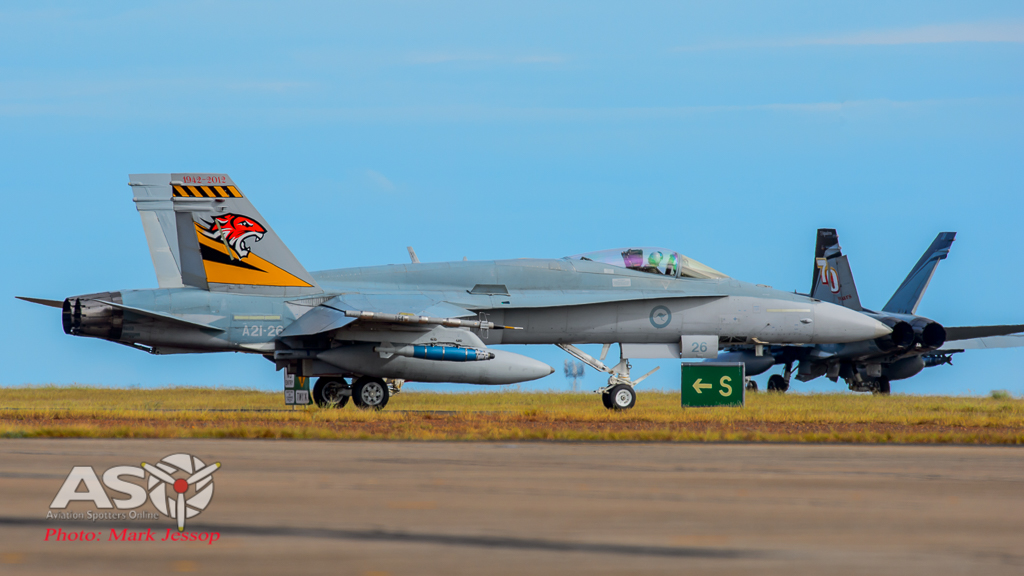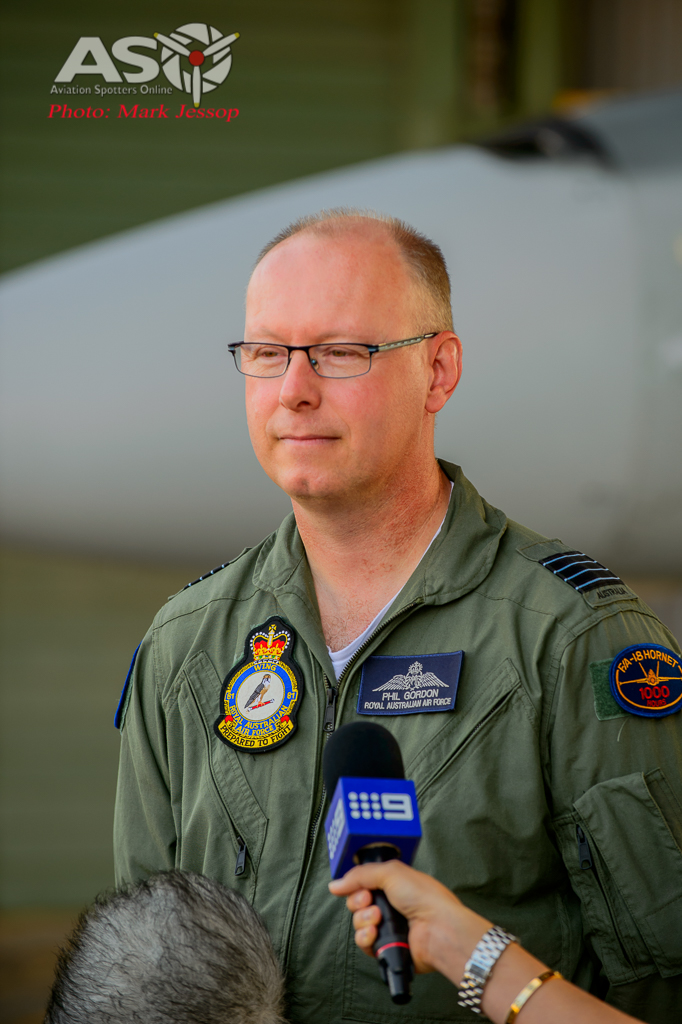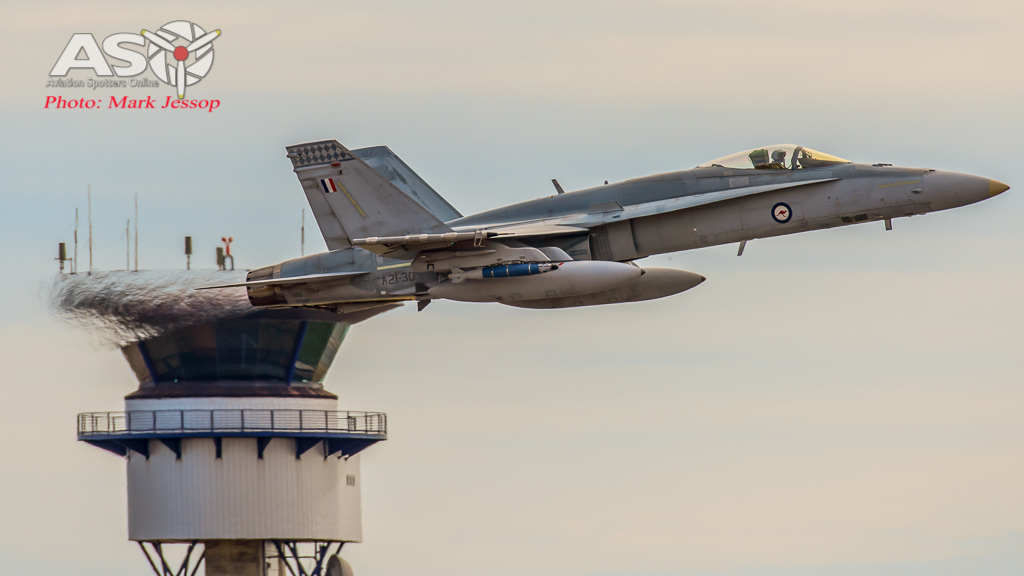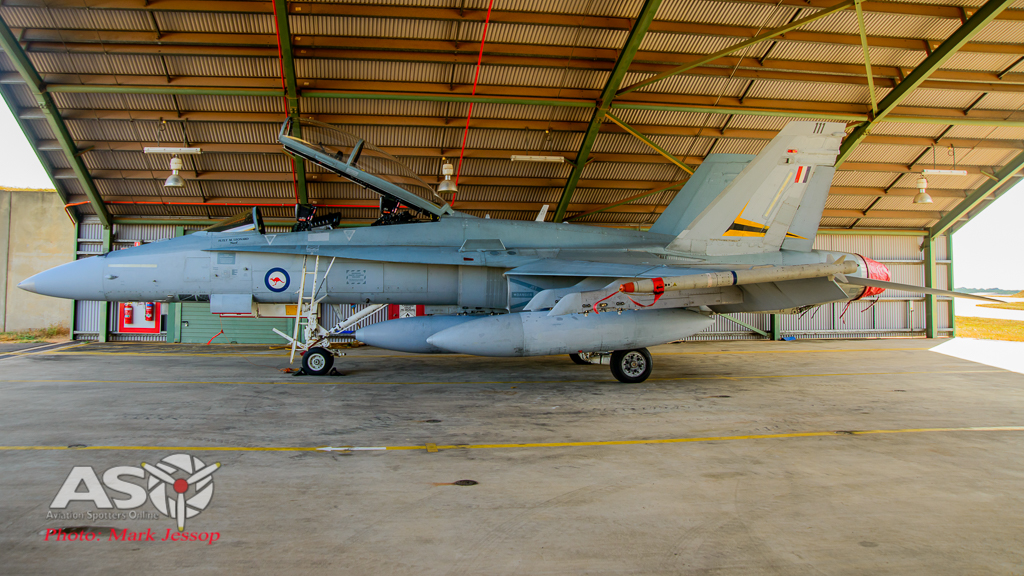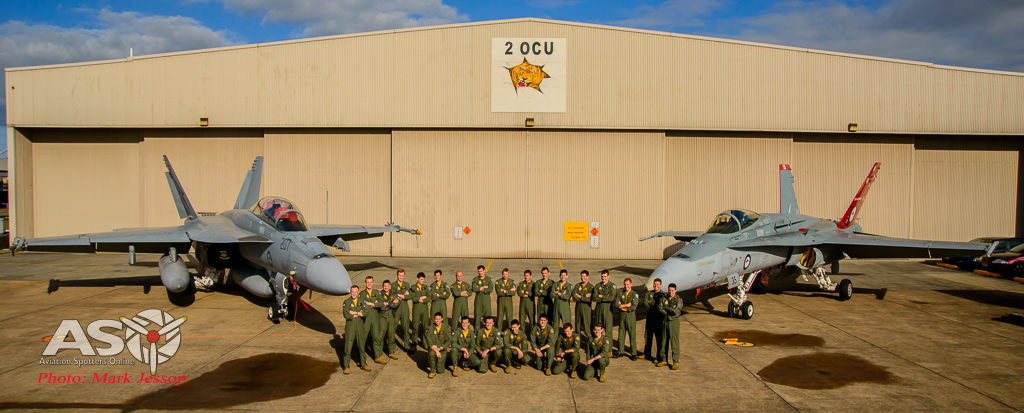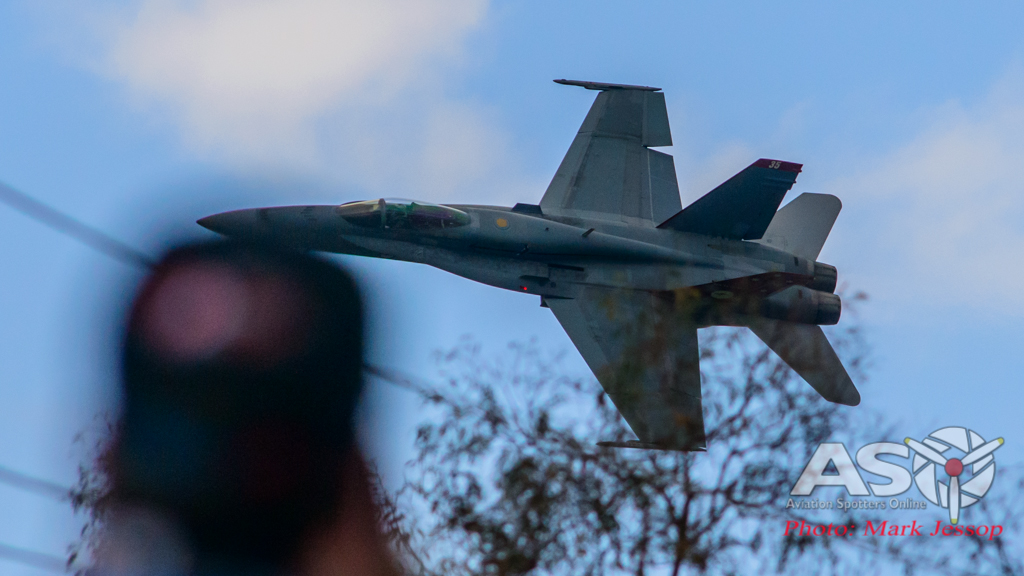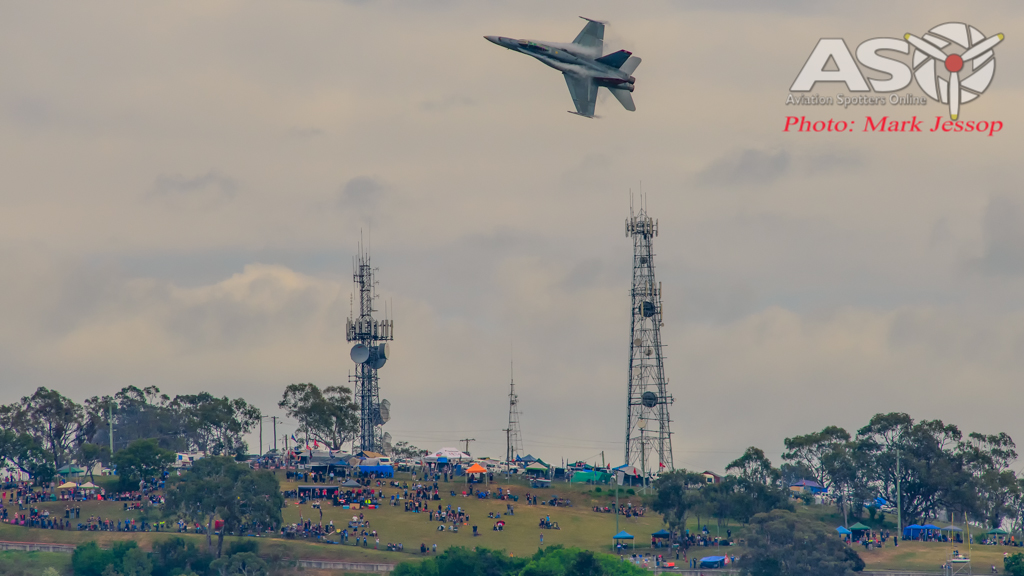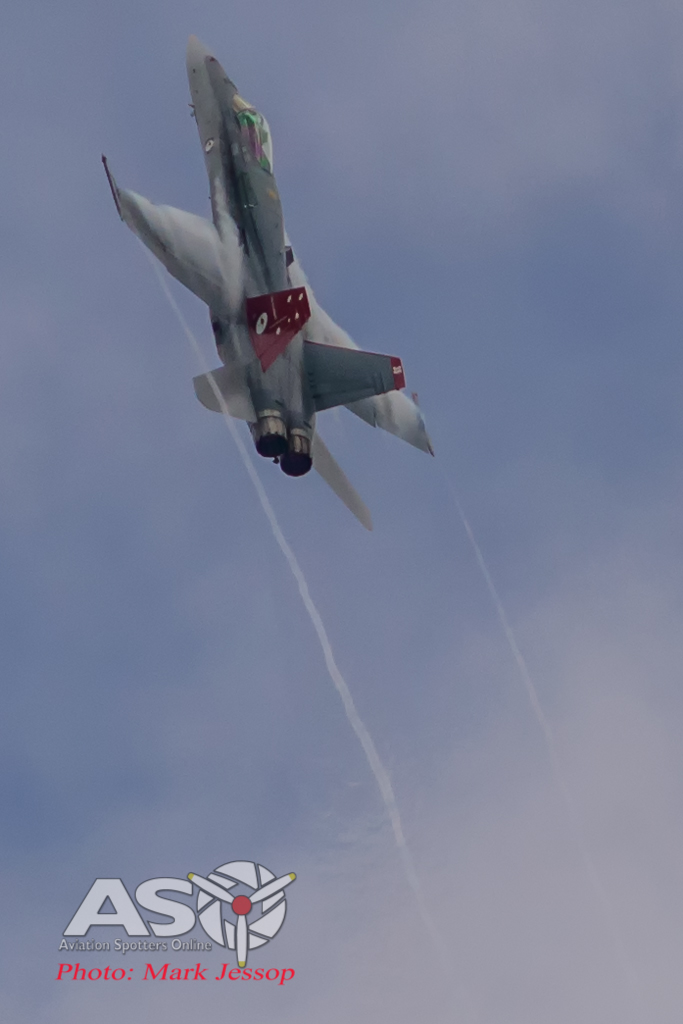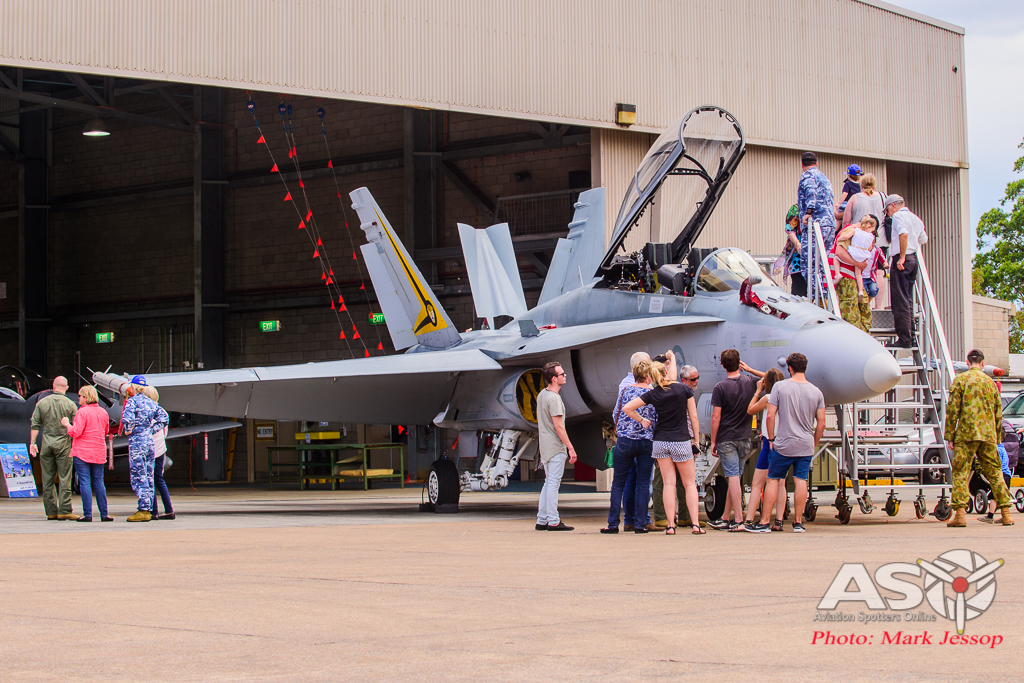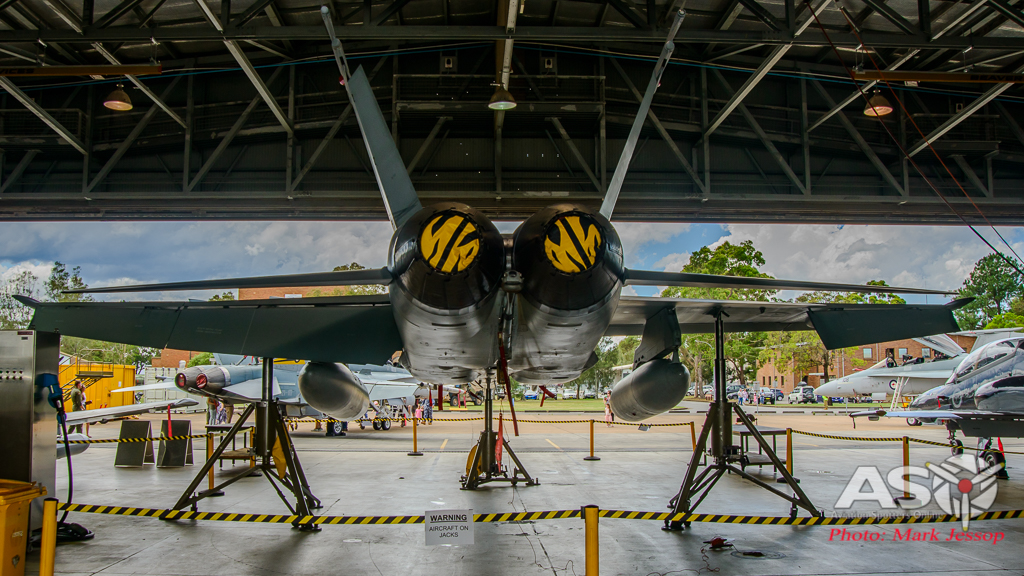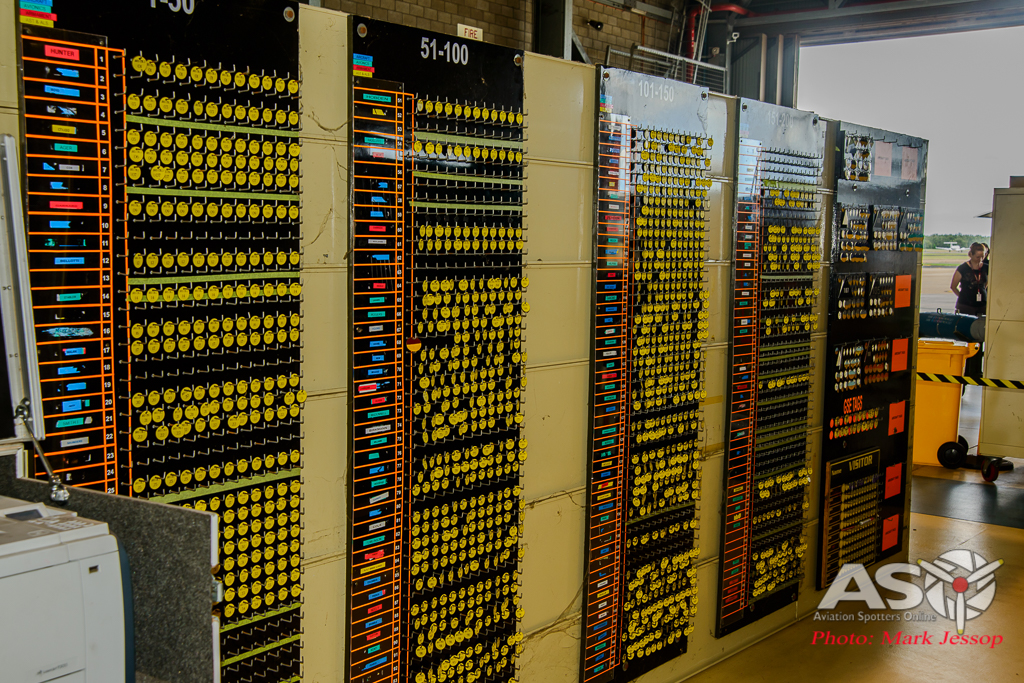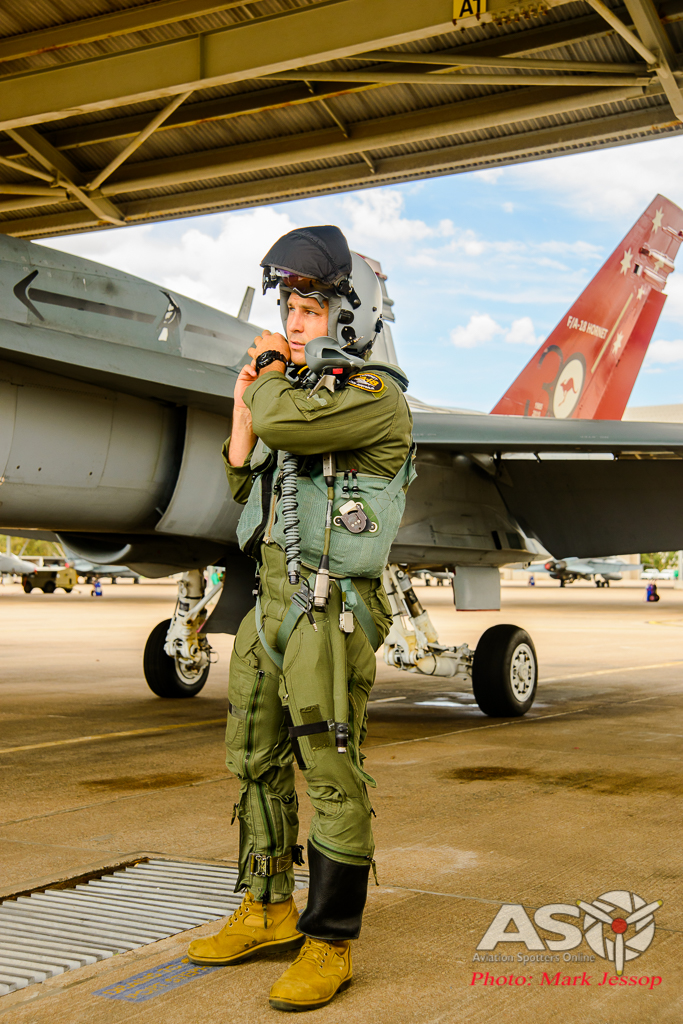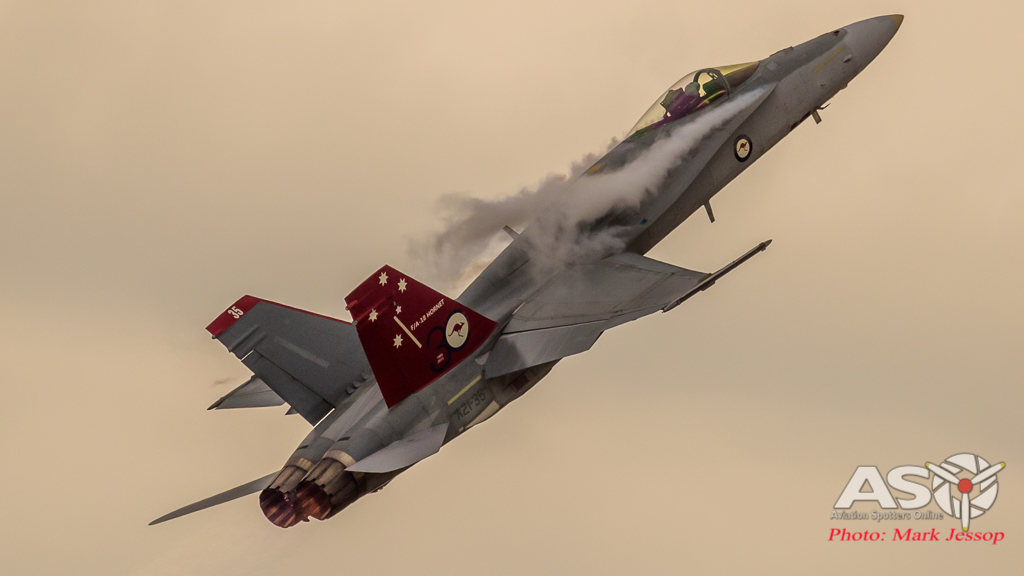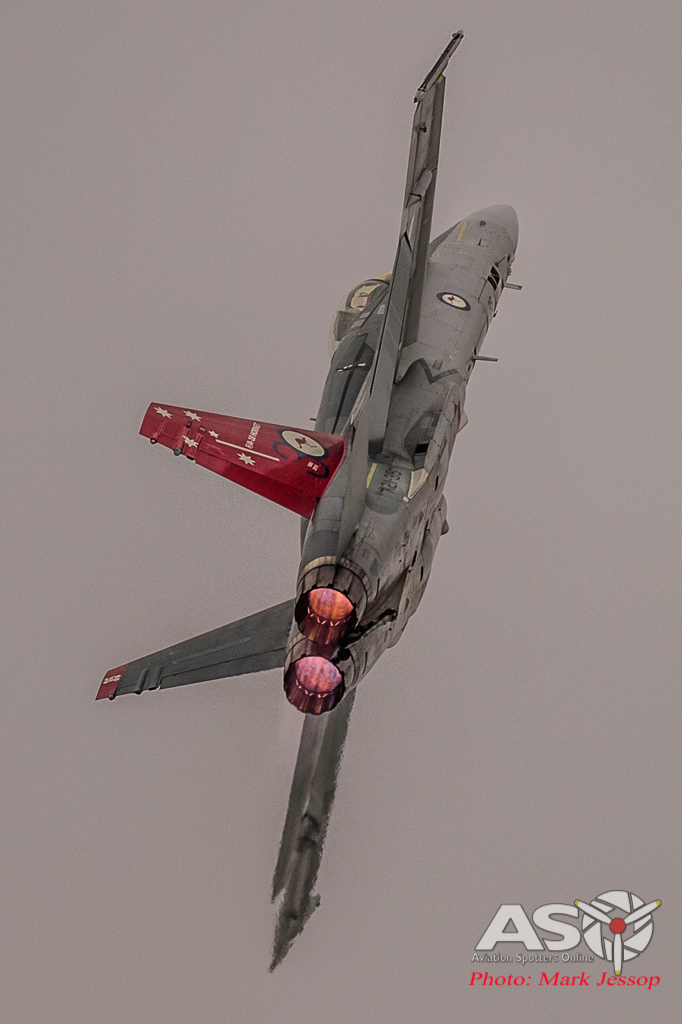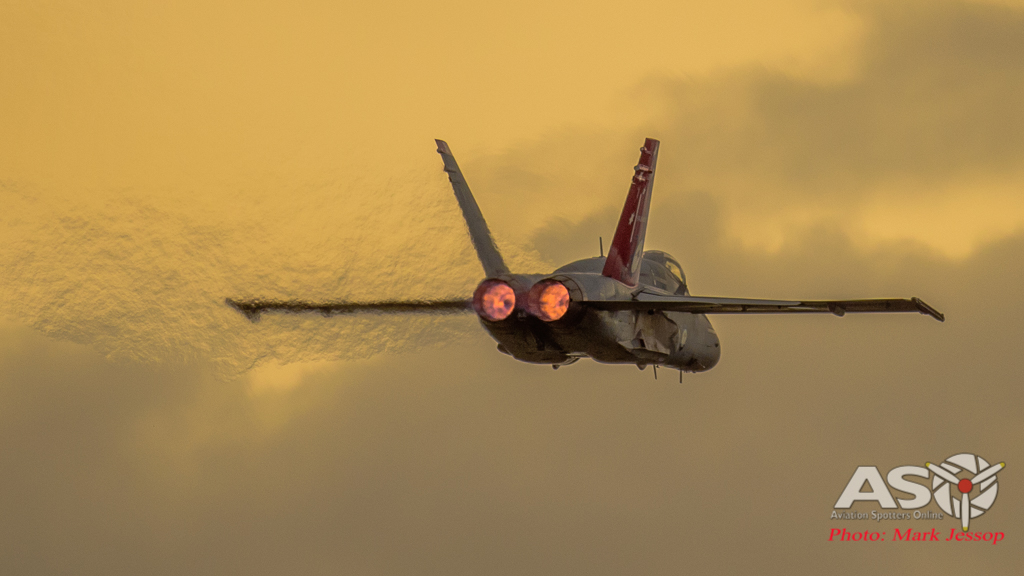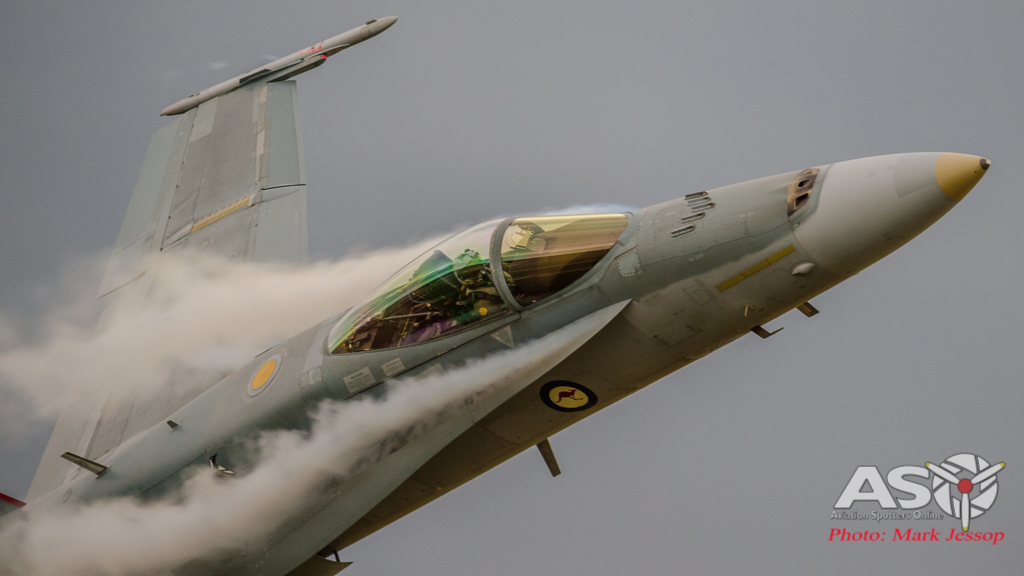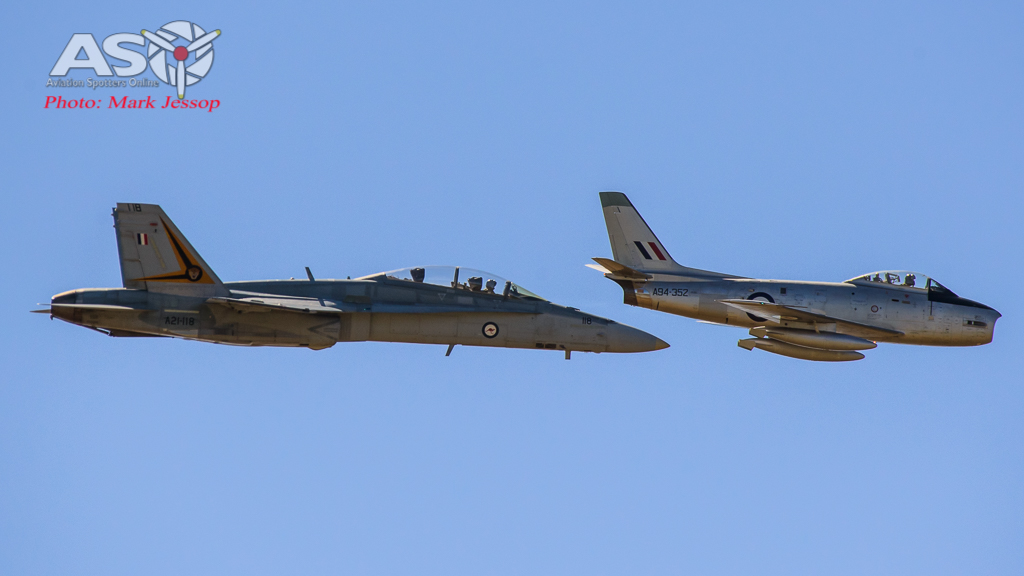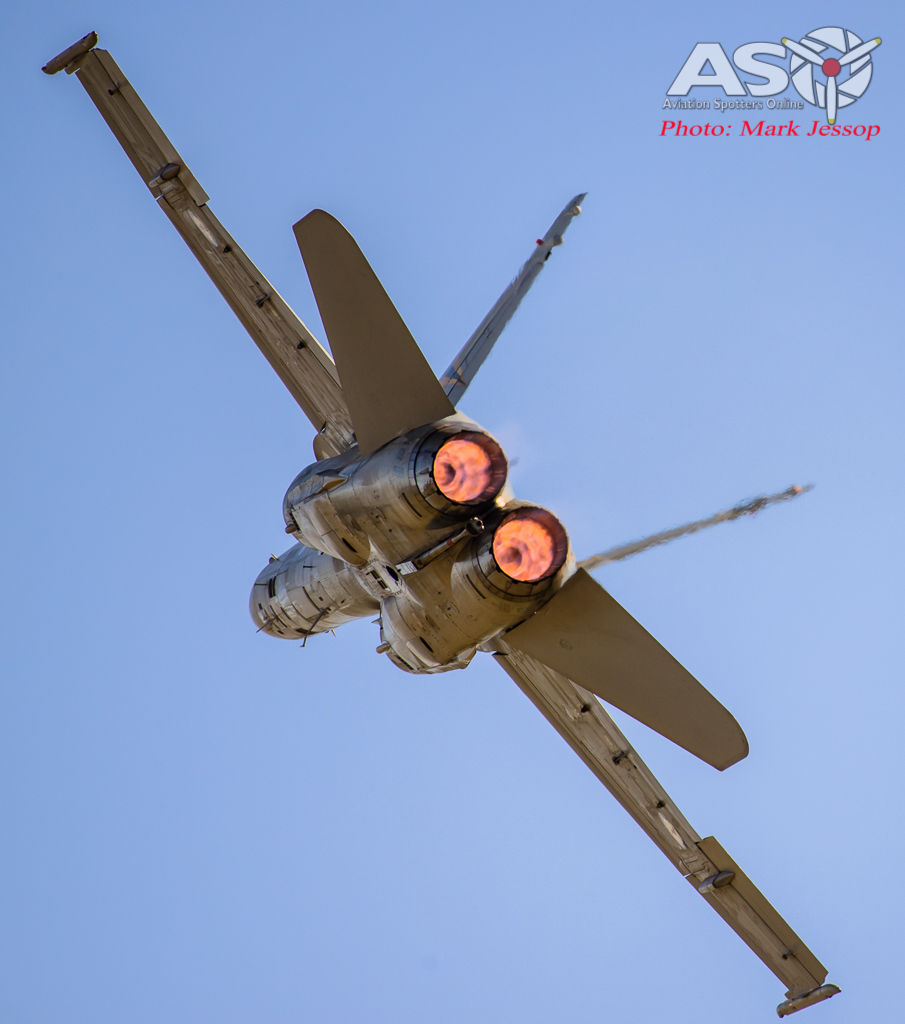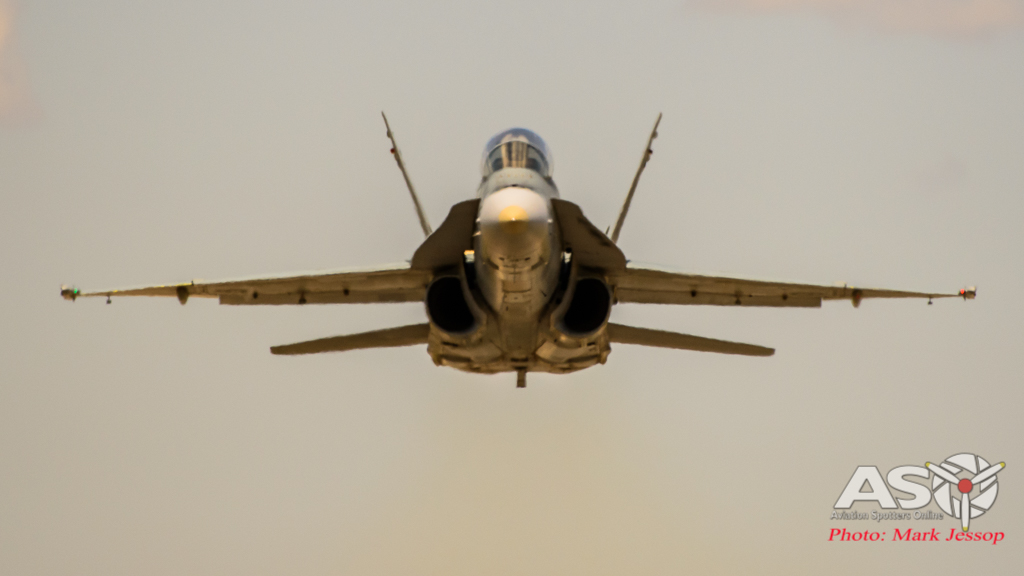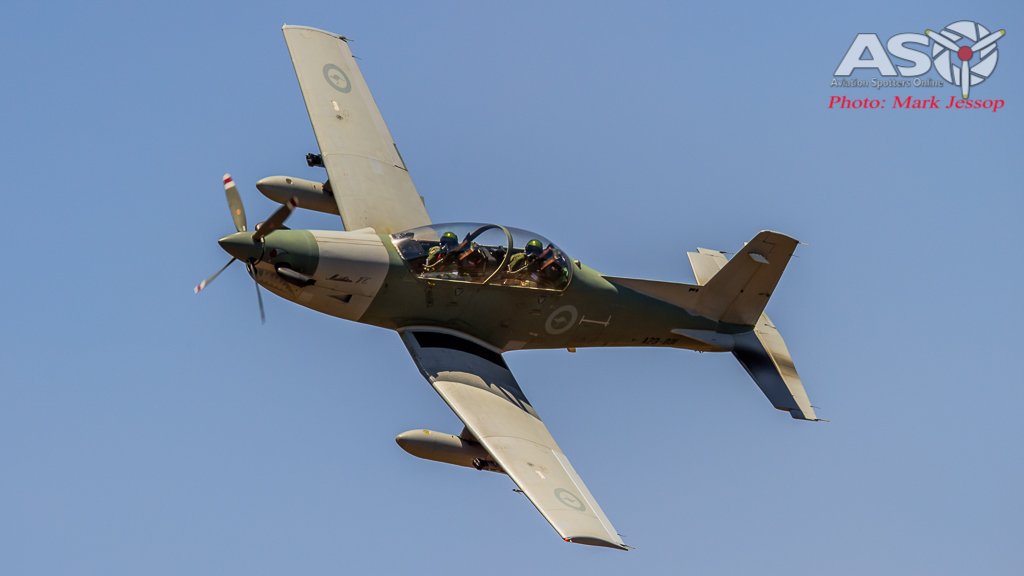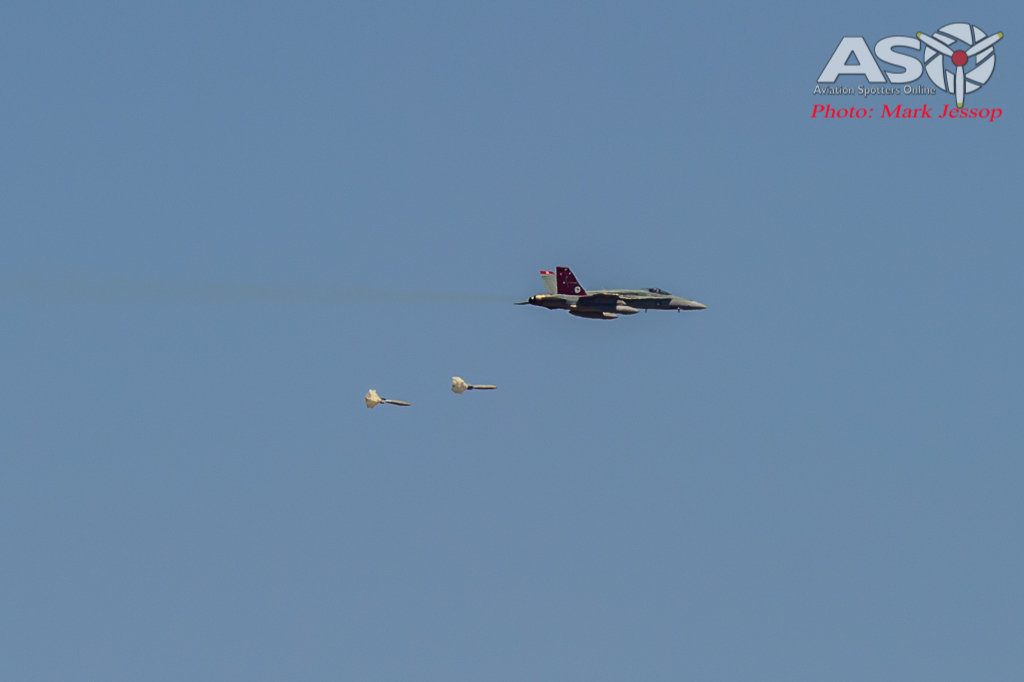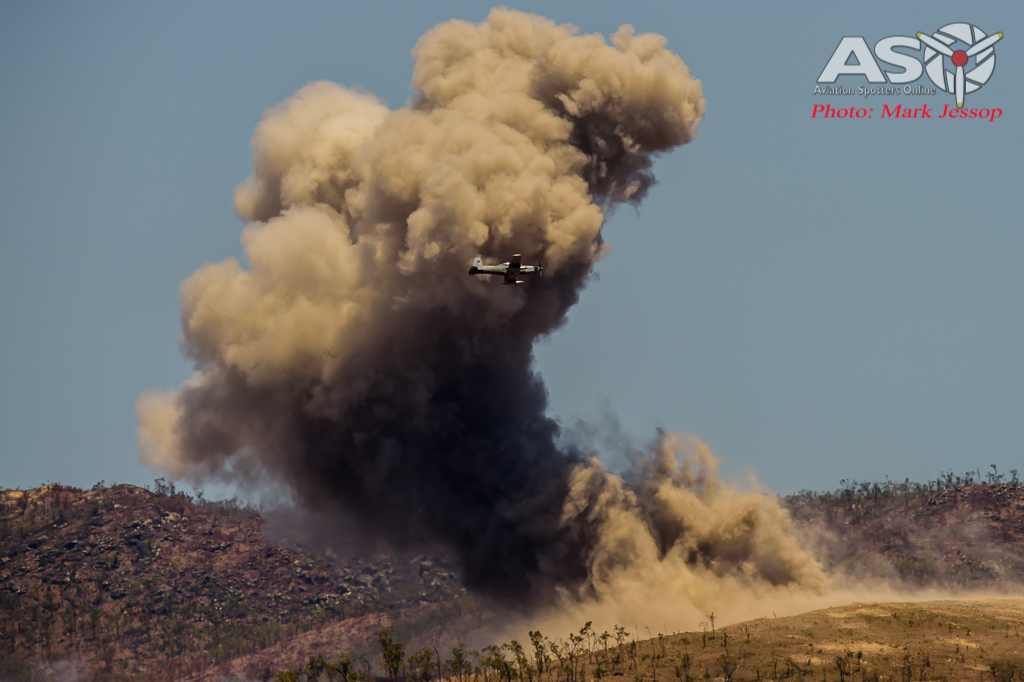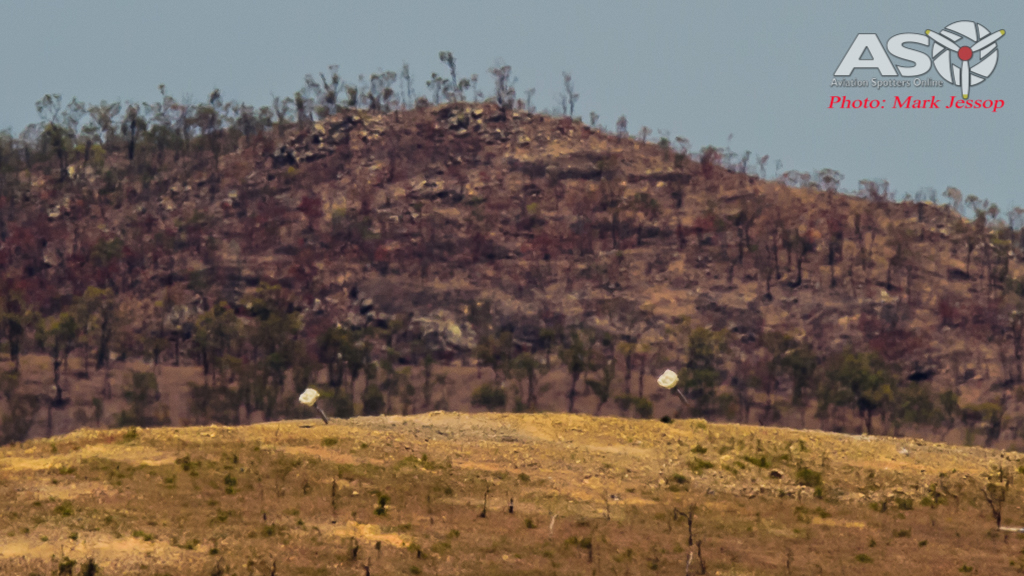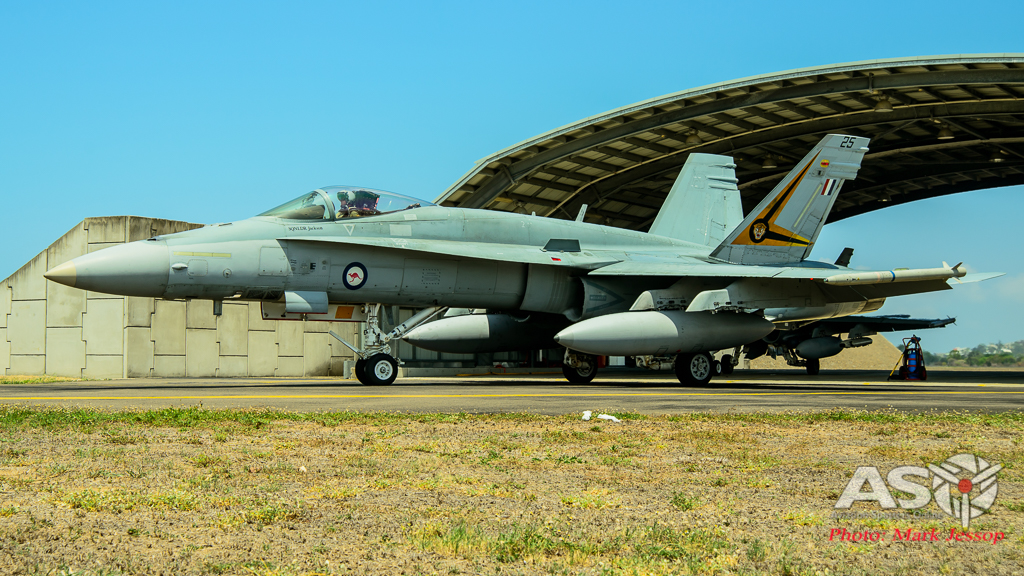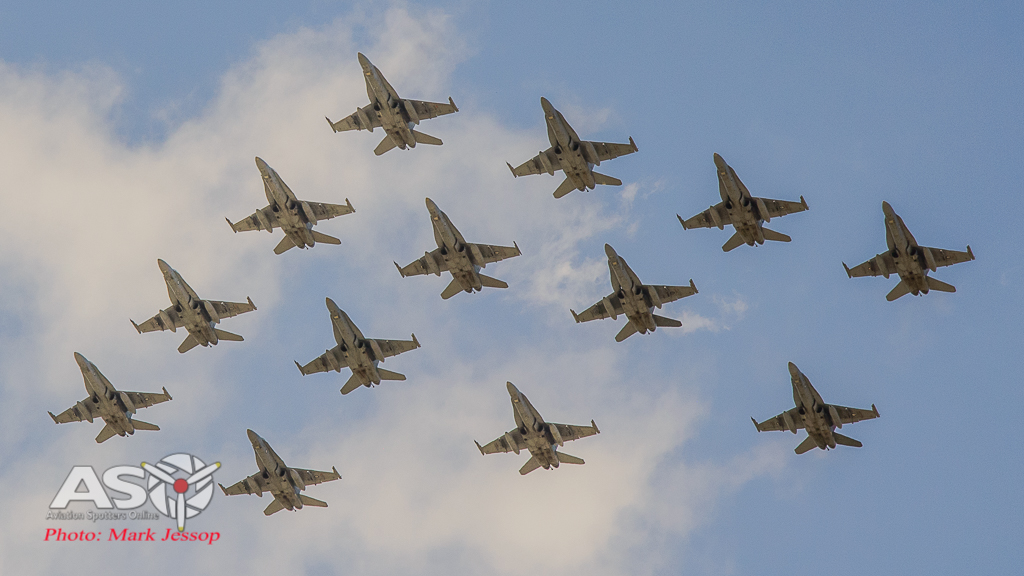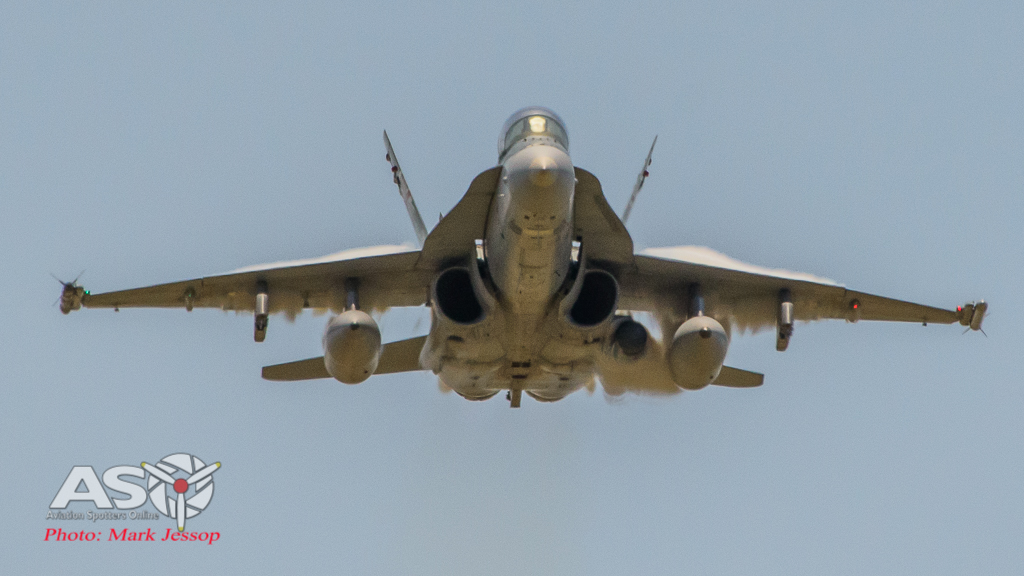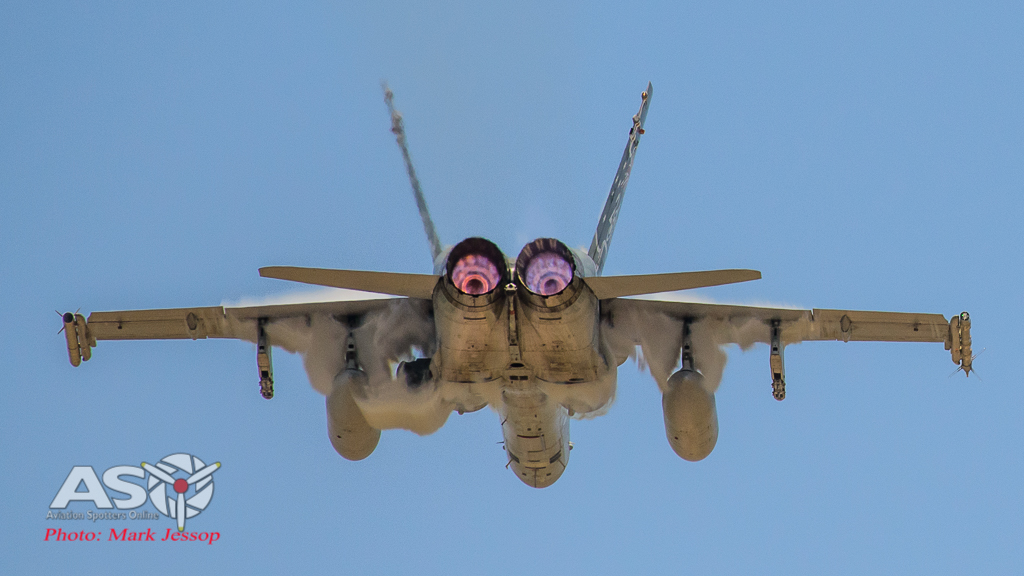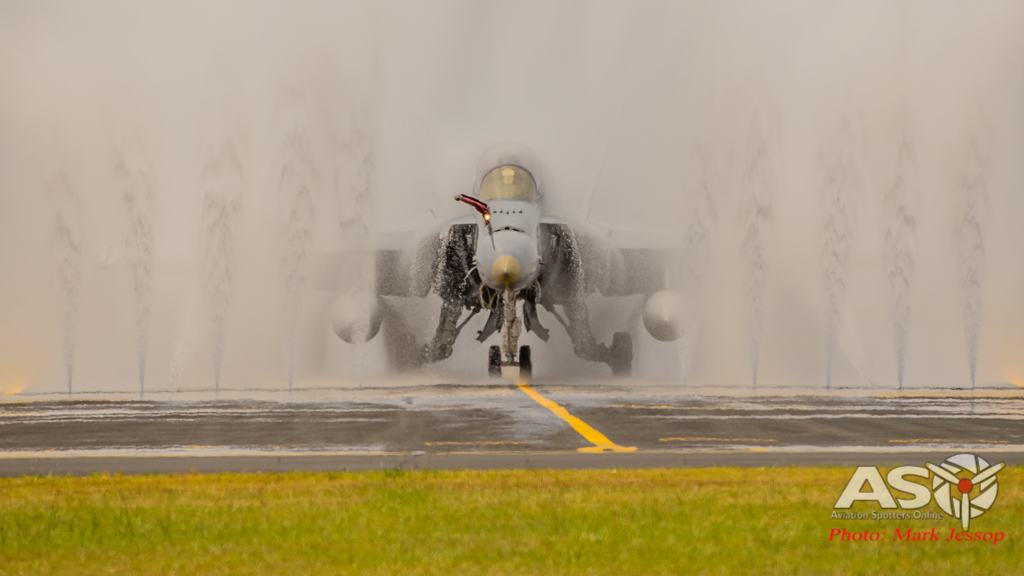Introduction
My ASO Co-Editor Mark Jessop has spent the last 12 months working closely with the Royal Australian Air Force 2OCU Tiger Squadron to document their year of operation. The following substantial article is a detailed look, a photographic and video journey into the little known world of some of our top and aspiring jet fighter pilots. For the RAAF pilots and crews every high G turn, every weapons release or public display is just business as usual, for you, our readers its a chance to see and hear what a year with the Tiger Squadron is like. Enjoy ~ Leigh
Year of the Tiger
2015 might go down as 2 Operational Conversion Unit’s (2OCU) biggest and most productive year since the introduction of the McDonald Douglas F/A-18A/B 30 years ago. Based at RAAF Williamtown NSW, 2OCU’s main role is to train and bring online the next generation of Fast Jet Fighter Pilots with their 6 month conversion course. Once pilots have completed their lead in fighter pilot training on the Hawk 127 at 79SQN RAAF Pearce WA and then 76SQN RAAF Williamtown, those chosen to fly the “classic” Hornet have one more hurdle, the F/A-18 Hornet conversion. If they complete this they will be qualified “classic” F/A-18A/B Hornet pilots.
Since 2015 marks 30 years since the introduction of the Classic Hornet, the RAAF has kept one of its long traditions going by painting the tail fins of A21-35 to commemorate the anniversary. This aircraft was chosen as the display aircraft for the 2015/2016 season with FLTLT Adam or call sign “Bung” from 2OCU, given the rare honor of being the display pilot for this season.
F/A-18A Hornet A21-35 30th anniversary scheme at RAAF Williamtown.
Australian International Air Show. 24/2-1/3/15.
To kick off the year, the first public display for the aircraft was at the Australian International Air Show at Avalon in Victoria. Bung performed each day from Wednesday to Sunday with the highlight being the Friday evening twilight display. Each day the famous Melbourne “4 seasons in one day” gave the photographers and public a chance to see the display in every different type of weather you can have, but nothing can compare to a twilight display to show off the after burners or flares. I very much look forward to the next time I get the chance to see a twilight display, as seeing the shock diamonds from the after burners going full tilt is a sight of which I will never get bored.
Link to the photos from the Australian International Air Show : http://aviationspottersonline.com/fa-18a-avalon/
RAAF F/A-18A Hornet A21-35 Friday Night Show Avalon 2015 Video
33rd Fighter Combat Instructor “FCI” course. Feb- June 2015.
With the Australian International Air Show over, it was time for 2OCU to get back to its most important role. Every two years the Fighter Combat Instructor course or FCI is undertaken by a few very select pilots through a six month course that has been described as being “like going to war for 6 months”. This year was the 33rd course and the tempo didn’t stop. After the first month the pilots had completed the training to be instructors on their chosen aircraft and from here on, it was onto the Air to Air combat training in the lead up to Exercise “Aces North” held at RAAF Darwin.
Speaking with Officer Commanding of 81 Wing, Group Captain Phil Gordon, about the role 2OCU and the 33rd FCI Course plays in maintaining the Combat Ready capability of the RAAF, he explains just how important this course is right now. “On this course we have four pilots flying the ‘classic’ Hornet and one flying the Super Hornet as well as two Air Combat Officers in the back of the Super hornets on the course as well. We put a lot of resources into the course and use ten FCIs to train and lead these aircrew to the next level. So we would use ten current FCI pilots to instruct on the course – seasoned professionals – we bring together to pass on their wisdom, mentor and guide them on the course.”
ASO: “Do these instructors change around as each instructor would have different experiences; so you are giving the new student an overall experience?”
“Absolutely” according to GPCAPT Gordon “and we take instructors who have been on exchange with USAF flying F-15E Strike Eagles; we have instructors who have been in combat as well as test and evaluation work in the USAF. So we have a large range of people who can really bring a broad perspective and who can pick out the best parts of everything to pass on to the students.”
ASO : “How many people would it take to make this course happen?”
GPCAPT Gordon: “There are a lot of people working behind the scenes to do anything in the Air Force, so it’s always hard when you try to count. For the four pilots who will graduate from 2OCU as Fighter Combat Instructors, the entire unit is working for six months to achieve that outcome and that alone is about 160 personnel”.
ASO: “So it’s not just the current FCIs that make these students the next FCIs, but overall it’s everyone who makes these students the next FCIs?”
GPCAPT Gordon: “Absolutely. We focus on the pilots, but we like to point out this course brings a lot of specialities together to learn how to work as a team, so it’s Pilots, Air Combat Officers, Air Battle Managers, Intelligence Officers and they’re just the ones that have students on the course that graduate with a qualification. We bring in a whole range of people and I think the Air Force, collectively, steps up a notch each time we run this course.”
ASO: “How do you now see the progression and capability has grown with the new assets the Air Force has?”
GPCAPT Gordon: “As commanding officer of 2OCU back in 2008 where I was running the course, I’m very familiar with what it takes to run the course so if I compare that to what I see now, we continue to push tactical boundaries and we challenge these students each year to really keep us at the cutting edge of tactics; so very much on this course we are looking to integrate Super Hornet with Classic Hornet and E-7 Wedgetail. ‘How can those capabilities most effectively work together?’ If I look back to when I was running the course in 2008 we didn’t have Super Hornet and we didn’t have Wedgetail, it was very much a classic Hornet focused course with F-111s at that time so that’s the stark example for me. As new capabilities are introduced, the FCI course gives us a vehicle to really exploit and learn how to best use that new capability.”
ASO : “How do the students get chosen to attempt the course?”
GPCAPT Gordon : “So, they have to be in the window of opportunity so we can’t have them too junior and if they are too senior they get moved into different directions for other tasks; so if they are somewhere in between that 3 to maximum 5 years from completing their own Hornet training, they have solid 4 ship leading skills and they demonstrate the aptitude with the drive and determination to do the course, then our senior pilots within the fighter force that look after the standards, tactics and evaluating people will basically get together and work out (who) we think is good enough to undertake the course”.
ASO: “How has the course evolved with the new assets coming online – like the Super Hornet and soon the Growler compared to when the only platforms were the Classic hornet and the F-111?”
GPCAPT Gordon: “Comparing the F-111 to the Super Hornet, the F-111 was very good in a very specific role but the Super Hornet which has now replaced it is essentially a newer version of the Classic Hornets here, is a true multi-role fighter so the diversity and the range of tasks you will be asked to do as a fighter pilot is far greater. There is a lot more we can do with this fighter and with this system of multiple aeroplanes working together that makes it far more capable than we were ever as single platform focus, but with that comes a degree of complexity that we have to train for.”
ASO: “Coming up to the last 4 weeks of the course, how are the students going and what is involved to get the students to complete the course?”
GPCAPT Gordon: “We like to joke that they are on the homeward stretch, they made it this far, don’t worry, but they just treat it as one day at a time. It’s a very demanding course and we put them under a great deal of pressure to bring out the best in them so they will just continue working hard as they have done, day by day, and mission by mission, to get to the end of the course; and then I think it will dawn on them that they have made it. Certainly in the 5 months since they started the course, we have seen a significant improvement and development in their abilities, their confidence and leadership. They are already optimising the characteristics of a Fighter Combat Instructor which we will graduate them as in a couple of weeks.”
ASO : “In a couple of weeks we have “Dawn Strike” which is the final mission of the course attacking RAAF Williamtown; how would you rate the experience for the pilot?”
GPCAPT Gordon: “I have very fond memories of the last Dawn Strike that I flew on. What we do essentially is all the new graduated FCIs are attacking Williamtown and everyone else is back defending Williamtown. So we get the whole Fighter Force I command up in the air as a blue on red battle. To take off out of Townsville to attack Williamtown, you take off at night and then as you are starting to get to the fighting airspace the sun is just starting to come up, you have that pink horizon on the fluffy clouds and there is just a wall of defenders in front of you that you just have to fight through with simulated missile shots and when you get through you deliver your simulated bombs on the base and land; and it’s still only 07:00 or 08:00 in the morning so it’s a very surreal experience but it’s very moving to know the whole wing has come together for this final graduating event and pretty much we get everyone airborne as part of that. I think the whole dawn thing and the sunrise adds to the whole magic of the occasion.”
ASO: “Is this a chance for all the pilots to sort each other out and have a go at the new FCIs ?”
GPCAPT Gordon: “Absolutely, we focus on just a small handful of pilots just doing the FCI course but they are our brothers and one of us so there is no ‘us and them’ in it, but all of the pilots, even if they are not on the course, are flying in support of the course, so everyone is involved in this. But being fighter pilots we remind them they are not as good as they think they are.”
ASO: “So once they have completed the course they will go back to their squadrons, and what are they bringing back to the new pilots coming into the squadron?”
GPCAPT Gordon: “We do it a couple of ways. Sometimes we send them straight back to an operational squadron. Typically they stay at 2OCU or 6SQN at RAAF Amberley with the Super Hornets and they will actually instruct, so their day job will be instructing. They will be teaching the next generation of fighter pilots to fly and be fighter pilots and then once they have consolidated those instructional skills, typically we will send them out to an operational squadron as the squadron FCI. They will be in charge of tactics development and leadership in a tactical sense of that squadron, they will very much help steer and develop the type of training we do. The squadron will have a Commanding Officer and Executive Officer “XO” etc, but the person that really drives the tactics that squadron flies is that squadron’s FCI, so these graduates here will be in that role in another year or two.”
Link to photos from Exercise ACES NORTH: http://aviationspottersonline.com/aces-north-darwin/
Final Mission “Dawn Strike”. 23/6/15.
With this being my 3rd ‘Dawn Strike’ that I have witnessed, I thought I was prepared enough for just how AWESOME this really is. The goal of ‘Dawn Strike’ is for the new FCIs to take off at 04:00 from RAAF Townsville, refuel twice with the second being right on sunrise and from there fight their way through every other Fighter Jet that the Air Force can get airborne, then fly a dummy attack on RAAF Williamtown. Going on to the base with the first glimpse of the light starting to show, you are just wishing it’s going to be that glorious golden light. Any any dreams and thoughts about pleasant light are smashed by the first jets scrambling at full tilt. From this moment on, the next 1.5 hours is the most INSANE AVIATION EXPERIENCE any aviation nutcase can have as a member of the public in Australia – and even some in the service would agree.
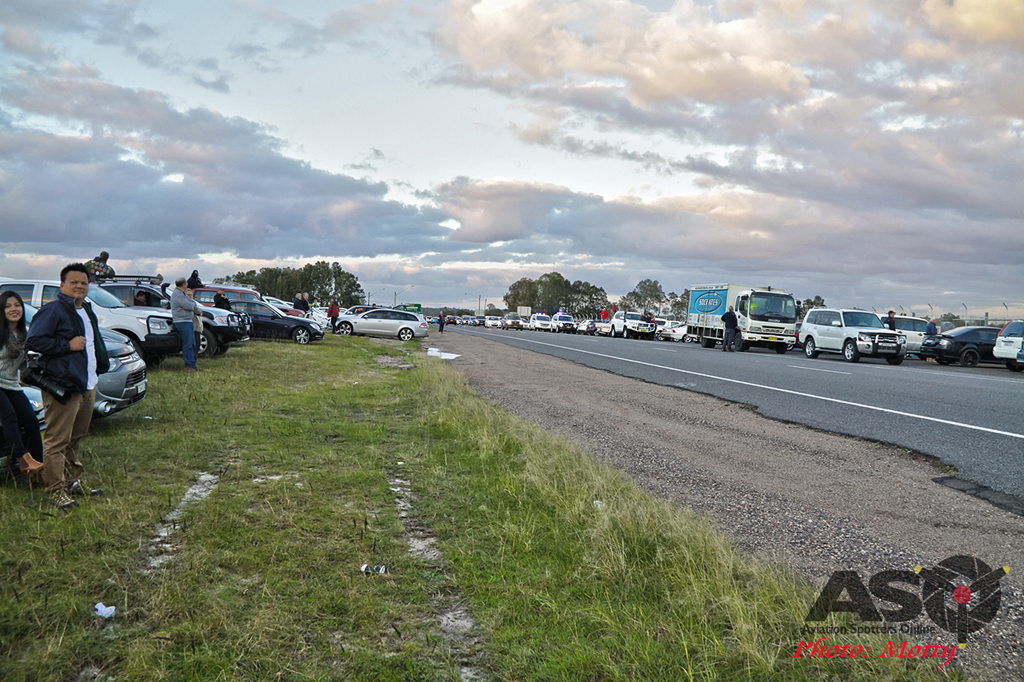
The public getting ready for the action.
From early in, the cars start lining up to get the best spots and by the time the first jets are heading back all around the base, the public have taken up every position possible so they can see the event. Without any warning, the first beat-up comes screaming at the base and if you didn’t know what all the hype was about – well you do now. Most beat-ups came at the base in pairs or fours and very quickly it was like every fast jet you had ever seen either doing beat-ups on the base or joining the line-up for landing.
It’s very hard to describe the visual explosion that happens with “Dawn Strike” but maybe one way could be if you remember the scene early in the movie “The Battle of Britain” where the BF109s come in at full speed and ‘zero feet’ – well this would be the modern day version. If you haven’t been to a “Dawn Strike”, I would put it on the list of all time Aviation events that has to be seen; maybe words don’t do this justice so I will let the photos do the talking.
Link for photos from the Control Tower : http://aviationspottersonline.com/fci-dawn-strike-from-the-tower-2/
Link for photos from Motty of “DAWN STRIKE” : http://aviationspottersonline.com/dawn-strike-motty-3/
Newcastle Mattara Display. 27/9/15.
In somewhat testing conditions around the Newcastle area, FLTLT Adam Bung somehow managed to still put on a cracking display over the famous Nobby’s beach in support of the local Mattara Festival. While many thought the display would be cancelled, right on cue, some of the rain moved out to sea enough for “Bung” to give the locals what they had come out to see – another cracking display – and due to the amount of moisture in the air, ASO photographer Darren “Motty” Mottram captured some great “ecto” in the very overcast conditions.
Link for photos from the Mattara Display: http://aviationspottersonline.com/newcastle-mattara-hornet-display-2015/
Bathurst 1000 Display. 10-11/10/15.
One of my favorite displays of the year is at the Bathurst 1000 Car Race with displays on the Saturday and Sunday. After going both days last year with one day on the east side and one on the west side of the track, I wanted to try another angle. I had been thinking about the first pass inbound up Mountain Straight with the turn across the Mountain, but once I was up on the Mountain beside the White control tower at the top, I knew I wasn’t going to get the shot as there are too many trees beside track for the idea that I had – but this can be a good thing to not lock yourself into one position. I moved around and found a nice clear spot with few trees around me and it was almost time for the display. Saturday was one of those days where the weather could do anything and did. Just before the display, a storm was out west but some good light started to appear and it was game on.
How close can you get to the Jet on the Mountain?
On Sunday the display was timed to be just before the start of the big race so I had to be on the east side to get as much good light on the jet as possible. Once the Virgin 737 departed the airspace, it wasn’t long before Bung was inbound again and while the big race might go all day, the 10-12 minute display is something worth the two hour drive each way for me. On the Saturday Bung exited along the start/finish straight but on the Sunday he came in on a different line, at pace, and pulled up right off the middle of the track and departed for the short 20 minute flight back to RAAF Williamtown. The Bathurst 1000 is a chance every year to see two FA-18 Hornet displays and with the number of different spots to do some spotting, I think this is another experience that has to go on the list of things to do and see. You have to see the display at least once from up on top of Mount Panorama, as you need to see a display at eye height, but for part of the display, the aircraft will be below you! It’s very rare to have a display below you!
Link for photos from the Saturday display : http://aviationspottersonline.com/bathurst-saturday-mountain-view/
Link for photos from the Sunday Race Day display : http://aviationspottersonline.com/2015-bathurst-1000-fa-18a-display/
2OCU Family Day Display. 6/11/15.
Every year, each Squadron puts on a family day to give serving members the chance to bring their family and loved ones on base, to give them an idea of what their work is all about. This is a really good chance to answer all those questions that family members could have about their loved one’s job. 2OCU opened up their hangar and had a great display showcasing the many different things needed to keep these jets in the air. Many people made the most of the chance to sit in a Fighter Jet, as well as just walking around one up close.
In the 2OCU hangar F/A-18B Hornet, A21-115 was up on its jacks with the undercarriage retracted – something you don’t see every day. All around the hangar, displays of different parts showed just how many things it takes to have these Fighter Jets in the air.
Link to photos from the 2OCU Family day : http://aviationspottersonline.com/2ocu-family-day-behind-the-scenes/
2OCU Display Pre-Flight.
One of the many tasks that not many get to see is the lead-up to a display and how the pilot gets ready. Walking around with Bung from the 2OCU building, he made it look like another flight on any day of the week. I’m sure every pilot has his own routine to get ready, but Bung seemed relaxed and even shared a few smiles with the fellow members of the 2OCU team as he signed for the aircraft; maybe because he had me following him around taking photos, it was enough for those not in the photo to “give a bit back” for once. With the whole process of putting on his G-suit, reading all the details about the aircraft, to walking out to the aircraft, it only took 10-15 minutes. This made me think, if it was for another reason and they had to rush to get an aircraft off the ground, I’m sure it would be airborne in a shorter time.
Once everything was signed for and everyone was happy, it was time to walk out to the aircraft and do the visual walk around which can look, to the average person, like just a casual walk around. But “Bung” quickly went from jokes with the team to very focused, as did the team preparing the aircraft for him. Walking around, he went over just about every panel and once the ground level check was done it was up on the aircraft to check all the panels on the top. Once he was happy with everything on the outside, it was time to strap in, fire up the engines and do all the system checks. The aircraft, once started, has a system self-check which moves the rudders, flaps etc and is a quite strange thing to see as it’s very precise and very quick at times.
Link for photos of the family day : http://aviationspottersonline.com/2ocu-pre-flight-walk-around-before-family-day-display/
With all the checks completed, it was time to get this show on the road. My position for the display was going to be at the control tower so once Bung gave the “chocks out” hand signal, I headed over there. A big weather front was hitting Sydney so just as the display was about to start, Bung had to hold and wait for three commercial airliners to land. This delayed the start time of the display, but once everything else was sorted out and landed safely, it was show time.
Sometimes everything falls into place and today was one of those days with the light changing from a really flat washed-out grey into to a really eerie golden light that I have never seen while shooting aircraft. The temperature dropped as the front was moving through and all this set up what I feel to be the best display I have seen in a long time. Blasting down the runway, it was very easy to tell this display was going to be insane, as the “ecto” coming off the leading edges from the first pull-up was just crazy. Ecto (short for ectoplasm) is the white wispy compressed air that comes off the leading edges when there is a lot of moisture in the air. After all the rain that had been falling in the days before, it was showing right now.
One of the things in Australia that is always hard to capture is the “Jelly” in the exhaust wash as you need a low ambient temp so the exhaust contrast is at its greatest. Many times in Australia, you will get it in the morning at an Air Show, but once enough heat from the runway is generated, the jelly disappears. But today I would see jelly like I have never seen it before, mixed with the eerie light over the front pass along the coast. Having seen this routine a few times now you could think I would be bored, but seeing this one from the Control Tower deck and up very close gives a new perspective of just how loud and quick a Fighter Jet is at full noise. While I was using the longest lens Nikon make, the 800mm 5.6f Nikkor, I soon found that I was getting only part of the Jet in the frame which is something many dream of and something I could get used to, very easily. With every pass, the light seemed to be getting better and I was just hoping what I was seeing in the viewfinder was what I would be seeing once I downloaded the photos. I don’t know what really makes one display stand out from another but this display was the display of the year for me with so much ecto and the light combined with the clouds passing over. I couldn’t ask for more.
Link for photos of the 2OCU Family Day Display : http://aviationspottersonline.com/2ocu-display-from-tower/
Warbirds Downunder 20-21/11/15.
The Temora Aviation Museums bi-annual Air Show is fast becoming the biggest Warbird showcase in the southern hemisphere. This year, 70 different aircraft were planning to turn up. In the week leading up to the Air Show there was a heat wave across the east coast of Australia with temperatures above 40c and very strong winds. The Friday twilight display was going to be a new addition to the Air Show, but for a while on the Friday it looked like not much would fly. Yet right on 16:23, SQDLDR Paul or “Simmo” came blasting from the edge of the crowd with his trademark high-speed top side pass. Since the second aircraft was following a short time behind, Simmo had one of those rare chances to put the F/A-18B through a small handling display as it had been a few years since his time as the Hornet Display Pilot back in 2005/2006.
With the wind calming down, more aircraft were able to get airborne for their display slots. Since FLTLT Adam was late, he was happy to do a few quick passes for the crowd and land. With the cool change passing through Friday night, everyone was hoping that the full day Saturday Show would be cooler and it was – at 32c and with little wind. Display time for the formation display of the F/A-18B Hornet and Jeff Trappet with his CAC Sabre was 15:06 and right on time the pair appeared in front of the crowd. A few passes later, “Bung” departed and waited for his slot.
Once the Sabre finished its display, it was time for Bung to show off what the current front line fighter is capable of – even after 30 years of service. This would be the last solo display of the year and Bung really gave the crowd a very good showcase of the performance of the Jet. Since this was the hottest temperature for a full display during the year there was little ecto or jelly, but even still the display was flawless.
On the Sunday both Aircraft left mid morning so they could get ready for Exercise “High Sierra”, this presented another opportunity to get some unique shots that can be difficult to get anywhere else – that’s looking straight at the Jets head on, as they take off. The first jet took off and put a lot of heat into the runway (but hey who cares), anytime you get to capture a jet head on is awesome so enjoy the few photos that I got.
Link for Photos from Warbirds Downunder 2015 : http://aviationspottersonline.com/warbirds-downunder-2015-sunday-departure-2/
Temora Hornet departure video
Exercise “High Sierra” 26/11-10/12/15.
To finish off the year, 2OCU moved up to RAAF Townsville for the final four weeks of the 15-1 Hornet Conversion Course. ASO was invited up to have a closer look at what it takes to become a front-line fighter pilot in the Royal Australian Air Force. I arrived in Townsville straight after Warbirds Downunder at Temora NSW and it was like I hadn’t moved half way up the east coast of Australia as the temperatures were the same – hot and dry and that’s how it stayed for the whole time I was there. As I hadn’t been to Townsville to take photographs before, I went out to meet some of the local spotters to get a feel for the place and get my head around the light that I would have to deal with all week. The bunch of spotters up there are keen and with the Exercise in full swing the afternoon was where the action was. But my first big day was an early start to meet my hosts and drive the hour west into the Hervey Range Military Area.
The mission for the day was live MK83 High Explosive 1000lb bomb drops on the range with the help from 4SQN Forward Air Controller or ‘FAC’ in their Pc-9 aircraft. Our location for the day was around 3km from the impact zone at one of the many observer huts spread out across the range. The sole FAC aircraft turned up right on time and once communications between everyone on the ground and those in the air had been confirmed, it was time to go to work. I have never been to a live range before and I wasn’t really sure what I was in for; I have seen quite a few mine blasts in big pits so I thought it would be something along those lines. The first call came in that we had an aircraft inbound. To show just how hard it is, it was a student who didn’t get it right the day before, so he had to come out and finish his task with practice bombs from the previous day before he could move onto today’s test.
Very quickly the chatter on the radio picked up but it wasn’t a rush of information; it was a very clear and precise call for what was needed and the location etc. First the FAC came in and dropped red smoke on the target which, at 3km, looked very clear as to what the target location was. Just as the FAC team was moving out of the area, there was the unmistakable sound of a fast jet on the hunt. From a distance, I could see the jet moving very fast and jinking around until it was on its final turn onto target. It took a very short line at the target with the release and enough moves to leave the area without staying on a straight line for too long. The student dropped straight onto the target smoke which I’m sure was good to see for him and me as well, to have so much riding on that drop. It was a very good sign for the rest of the day’s action.
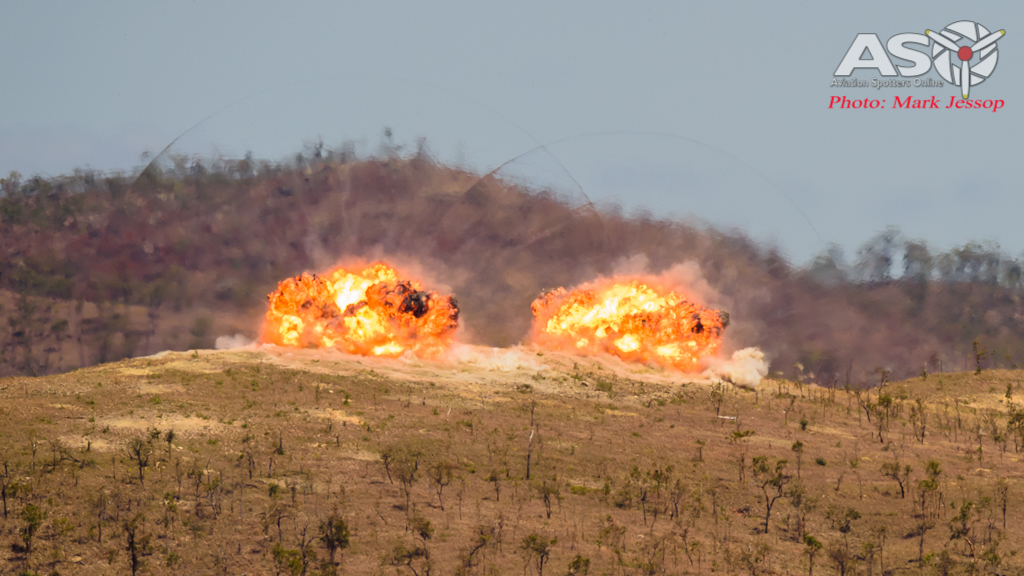
2x MK83 High-Drag High Explosive impacts on the Target.
The first live drop was called in not long after and, following the first strike, it was a continuous mission for all the students and instructors for around two hours. Again the FAC team called in very clear information and not long after I could see two jets inbound. They followed the short straight line at the target and the first jet dropped both bombs that, with the help of their small parachutes to slow them down, hit the target not long after the jet passed. Yet it took 12 seconds for the sound to hit and even at our distance, it sounded extremely loud. From here, the rest of the day was watching the different types of drops and listening to the team work, from the FAC team to Fighter Pilots: I have to say, even with all the technology the Fighter Pilots have to use, getting immediate precise feedback with corrections if needed, was very impressive to see in real time.
The next day was back at RAAF Townsville capturing all the action around 2OCU and their efforts launching morning and afternoon missions to get these new students up to speed and hopefully passed as the next Fast Jet Pilots. Again, it was an early start – fine by me as I wanted to beat the heat after close to two weeks of above 40c. But would that happen? No chance! But I wasn’t the only one feeling it and for me that made my job a lot easier. When I watched the pilots get out of their aircraft it was easy to tell that under the canopy, mixed with the pressure of the course, they were feeling it a lot more than I ever would.
It was a great day spending time with all the team from 2OCU and seeing how, at this level, it all works. Most people will never see such exercises this close or this much under the pump, ensuring everything was right. The teams worked around the clock making sure everything was ready for the next mission and not only was this for 2OCU but also for 4SQN. All the personnel I met and talked to, ranged in age from 20 to over 40 but everyone enjoyed their role and even in the heat could crack a smile and joke while at the same time understanding their own role and how that made a difference to the students on the course.
Link for photos from on base at RAAF Townsville : http://aviationspottersonline.com/raaf-townsville-high-sierra-2015/
Link to photos from the Live Bomb Range : http://aviationspottersonline.com/exercise-high-sierra-2015-live-range/
Videos from the range:
FA 18A Hornet Pass on the range – length 00:36
FA-18A and PC-9 FAC forming up – length 3:10
PC-9 FAC 4SQN flypass – length 00:13
All videos available via the ASO YouTube Channel
2OCU ” Tiger Bird ” formation homecoming. 10/12/15.
After a short rest in Townsville, it was time for the students and instructors to come home after what has been a very busy year for 2OCU. Like years before, the team fly down from RAAF Townsville and refuel twice then drop down over southern Queensland and head down the east coast at low-level from the Gold Coast all the way to their home base at RAAF Williamtown. As they approach the base they form up in a big diamond shape which they call the “Tiger Bird” and proceed over the base on to Newcastle before splitting up into sections for a quick beat up on the base. After a quick taxi back to the carports, it’s time to see the family again. A quick debrief with a talk from GPCAPT Gordon revealed just what a massive year it has been for 2OCU with all 8 students completing the Conversion – the most in the 30 years of the Hornet Conversion Course!
Link to photos from the 2OCU “Tiger Bird” formation fly over with the last beat ups of the year : http://aviationspottersonline.com/2ocu-tiger-bird-is-the-final-flight-of-the-year/
Thank you:
I have to thank the Royal Australian Air Force for what has been the most incredible year for allowing me the access that I have had. Next thank you is to the WHOLE squadron from 2OCU – helping me capture their work in what is now known as their busiest year in 30 years. Also to the RAAF PAOs for putting up with my endless emails and phone calls.
I would also like to thank Nikon Australia and the Nikon Professional Services team for showing faith in my work as well as letting me use the best camera gear in the world!
But most of all to my wife and family for the years of support to let me chase this crazy dream I have……….Thank you. – Mark Jessop.
Dont forget to subscribe to get email notifications everytime ASO release a new article.

